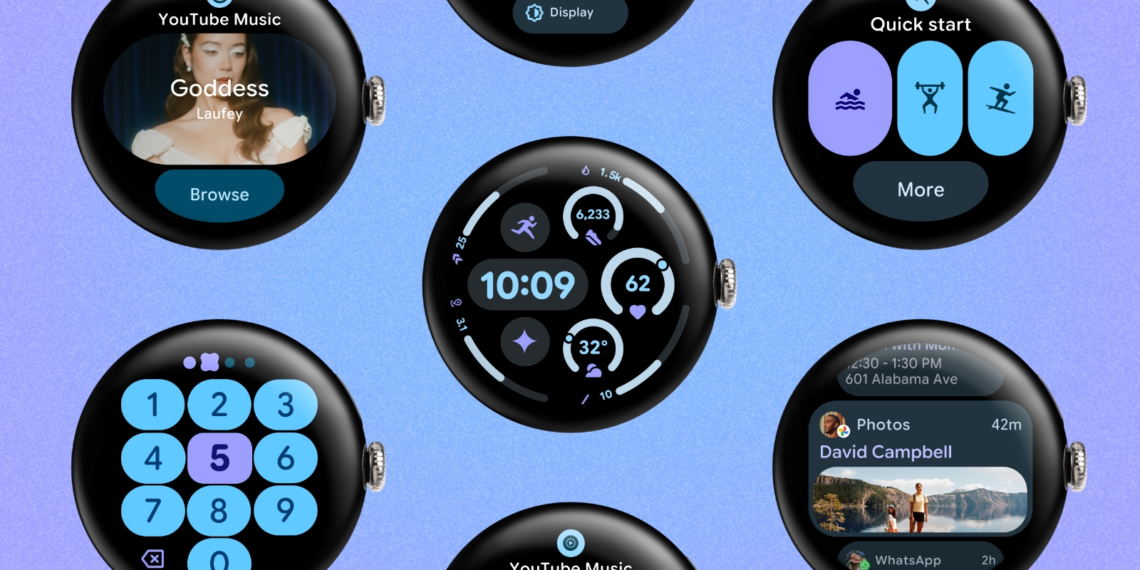Wear OS 6 is the latest update to Google’s smartwatch platform, aiming to elevate both performance and personalization. It introduces Material 3 Expressive, a design system focused on delivering modern aesthetics with enhanced visual elements and motion features. This refresh emphasizes individuality, allowing users to customize their experience while maintaining a sleek and contemporary interface.

The update also brings significant improvements in battery efficiency, with devices transitioning from Wear OS 5 to Wear OS 6 expected to see up to 10% longer battery life. These changes were made possible through optimized platform adjustments, ensuring a balance between dynamic visuals and practical usage.
Key Takeaways
- Wear OS 6 enhances customization options with updated design elements.
- Battery efficiency is improved by up to 10% on supported devices.
- The update balances modern visuals with practical performance.
Wear OS 6 Developer Preview

The Wear OS 6 Developer Preview, built on Android 16, introduces updates tailored for developers. One notable enhancement includes a more polished always-on display, designed to improve functionality and consistency. Developers can test their applications for compatibility with the updated system using the latest Wear OS 6 emulator. These updates also offer opportunities to adapt apps to the platform’s performance improvements and refined user experience.
Material 3 Expressive on Wear OS
Customize experiences with vibrant color themes
Wear OS now offers dynamic color theming to create personalized experiences. Using Wear Compose Material 3 and Wear ProtoLayout Material 3, developers can align app and tile designs with a watch face’s colors, enhancing visual harmony. These libraries include expanded color palettes, updated typography, and diverse shapes that add depth and character to designs.
Tiles on Wear OS 6+ devices automatically use system fonts, ensuring consistent text across the interface. The adaptive color system offers seamless transitions between different screen elements, making the design feel unified and expressive.
Enhance usability with redesigned tile layouts

Material 3 Expressive introduces improved frameworks that embrace the circular screen format of Wear OS. These new tile components are visually consistent and easier to read at a glance. The three-slot tile layout designates spaces for a title, main content, and a bottom slot, optimizing readability on small displays.
Developers can now build glanceable tiles that streamline actions and highlight critical information efficiently. This approach simplifies interactions, making it convenient for users to quickly access relevant data or perform tasks with minimal effort.
Optimize actions with round-display-focused UI elements
Wear OS now incorporates specialized components designed to adapt seamlessly to circular screens. One standout feature is the EdgeButton, which maximizes available space by integrating near the edge of the display. These buttons, available in four sizes, enhance accessibility and keep functionality compact.
Lists feature expressive motion using TransformingLazyColumn technology. This ensures smooth scrolling, where items adjust their size as they approach screen edges. Components such as cards automatically scale down during navigation, strengthening visual fluidity.
Progress tracking also gains refinement with full-screen and compact ProgressIndicators, presented as segmented visuals to assist users in understanding status efficiently. Combined with ScrollIndicators, users can monitor their movement through lists more intuitively, tailored for the circular interface.
Customizing Watch Faces
Wear OS 6 introduces exciting enhancements for watch face design. Version 4 of the Watch Face Format allows for greater visual customization, including smooth animated transitions between ambient and interactive modes, as well as options for photo-based designs. Developers also gain access to a new Watch Face Marketplace API, streamlining distribution. These updates are compatible with devices like the Pixel Watch 3, enabling users to enjoy stylish designs with rich typography and seamless functionality.
Updates to Libraries
ProtoLayout
The ProtoLayout tools have been refined to offer a smoother experience for developers. A new Kotlin-based library, protolayout-material3, brings advanced visual features such as support for Lottie animations, expanded gradient options, and fresh arc line styles. This allows for more engaging and customizable designs.
Developers also benefit from a more intuitive Kotlin development process. Updated APIs now closely match Jetpack Compose practices, including type-safe builders and improved modifier syntax. These adjustments make coding simpler and more cohesive with existing Kotlin workflows.
For example, displaying text on a Tile has become easier with these improvements. Developers can define layout elements using primaryLayout within a material design scope, enhancing both readability and functionality. These changes are aimed at addressing common developer concerns and improving overall productivity.
Credential System for Wear OS

The Credential Manager API enhances authentication on Wear OS devices, starting from version 5.1. It brings standardized authentication features like passkeys with a uniform platform UI, ensuring a seamless experience similar to mobile devices.
Developers benefit from the Jetpack library, which provides a simplified way to implement authentication. The system streamlines workflows by allowing developers to reuse much of their existing code from other platforms. It supports various methods, including passkeys, passwords, and Sign in With Google, while offering the flexibility to keep additional methods as backups.
Users gain a passwordless authentication option, making it easier to log in even when their phone is not nearby. The consistent and intuitive interface ensures simplicity and convenience across supported devices. Google Pixel Watch users were among the first to access these features, setting a new standard for wearable authentication.
Improved Media Options on Wear OS
Wear OS devices running version 5.1 or later now feature enhanced media controls, designed to simplify how users interact with audio content. These updates, available on platforms like the Google Pixel Watch, include the ability to fast-forward and rewind podcasts directly from the watch screen.
Additionally, users can access playlists with options for shuffle, like, and repeat, all through a redesigned menu. This streamlined interface enhances convenience during playback.
Developers benefit, too, as existing implementations for action buttons and playlists integrate these features seamlessly. For those using Google Assistant, managing and playing media becomes even more intuitive and efficient with these updates in place.
Begin creating apps on Wear OS 6 today
Developers now have a variety of tools to start crafting apps specifically for Wear OS 6. Key resources include:
- Compose for Wear OS codelab: A practical way to learn about building interfaces tailored for wearable devices.
- Wear OS emulator: Use the latest version to test apps efficiently in a virtual smartwatch environment.
- Github samples: Explore ready-to-use examples to better understand app workflows for Wear OS.
For those targeting younger users, there’s potential to design apps for options like the Galaxy Watch for Kids. This smartwatch, created for children, enables phone-free connectivity and independent exploration within the Wear OS ecosystem. Developers can leverage updated guides focused on kid-friendly app creation to tap into this space.
Google I/O 2025 updates available starting May 22 will provide more detailed announcements and opportunities. Looking for hands-on support? Consult Wear OS’s developing guides for further insight.
Frequently Asked Questions

What advancements in battery performance and efficiency does Wear OS 6 offer?
Wear OS 6 brings refined power optimization features, delivering up to a 10% improvement in battery life. This ensures smartwatches can handle daily usage more effectively without frequent recharging.
In what ways does Wear OS 6 improve the user interface and overall interaction experience?
The system introduces a refreshed design with the new Material 3 Expressive. This update focuses on better personalization and simpler navigation, making interactions smoother and more intuitive.
What new health and fitness monitoring tools are included in Wear OS 6?

Wear OS 6 integrates advanced health tracking features, such as more precise activity metrics and improved compatibility with various fitness platforms, supporting a healthier lifestyle.
Which smartwatch brands and models support Wear OS 6?
Compatibility includes a wide range of modern smartwatches from major brands. However, updates may depend on the specific manufacturer and model capabilities.
What security enhancements are part of Wear OS 6?
This version introduces stronger data encryption and additional privacy features to safeguard user information, ensuring a more secure experience.
How does Wear OS 6 impact the experience for app developers?
Wear OS 6 provides developers with updated tools and frameworks, making it easier to build efficient and feature-rich applications tailored for wearable devices.





































